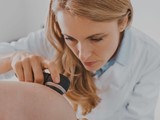Skin Cancer: Causes, Diagnosis and Treatment

Skin cancer is one of the most significant health issues globally, impacting millions each year. Did you know that ultraviolet (UV) rays from the sun are the main cause? Both types of UV rays—UVA and UVB—play a role: UVA rays accelerate skin aging, while UVB rays are responsible for sunburn. Together, they can damage DNA in skin cells, leading to abnormal growth that may result in cancer.
People in sunny regions, like Australia, face a particularly high risk. This article explores the causes, diagnosis, and treatment options for skin cancer, with a focus on leading facilities such as Al Nour Skin Centre.
Which Areas in Australia Are Most Affected by Skin Cancer?
Perth, the capital of Western Australia, is especially vulnerable to skin cancer due to its sunny climate. As Australia’s sunniest capital, Perth averages 8.8 hours of sunlight per day and experiences hot, dry summers from December to March. The high UV exposure here has led to increased skin cancer rates among residents.
Key Factors Contributing to Skin Cancer
In addition to intense UV exposure, other factors can raise the risk of skin cancer:
- Family History: A family history of skin cancer, especially melanoma, increases an individual’s risk. Regular check-ups at reputable clinics like Al Nour Skin Centre in Perth are essential if you have a family history of skin cancer.
- Abnormal Moles: Having numerous or unusually large moles can elevate the risk of melanoma, a severe form of skin cancer.
- Low Melanin Levels: People with lighter skin, eyes, or hair have less melanin, making them more susceptible to UV damage and, therefore, at higher risk for skin cancer.
- History of Severe Sunburns: Multiple severe sunburns, particularly in childhood or adolescence, significantly raise the risk of developing skin cancer.
- Weakened Immune System: Individuals with weakened immune systems due to medical conditions or treatments are at a heightened risk for skin cancer.
- Previous Radiation Exposure: Past radiation treatments, whether for skin conditions or other health issues, can increase skin cancer risk. If you’ve undergone radiation therapy, periodic check-ups at clinics like Al Nour Clinic are recommended.
- Geographic Location: Living closer to the equator or at higher altitudes, where UV radiation is more intense, increases one’s UV exposure and risk of skin cancer.
- Advancing Age: The risk of skin cancer, particularly non-melanoma types, generally increases with age.
- Xeroderma Pigmentosum: This rare genetic condition results in extreme sensitivity to sunlight, drastically raising skin cancer risk.
How is Skin Cancer Diagnosed?
Diagnosing skin cancer often involves a skin biopsy, where a dermatologist removes a small sample of the affected skin to examine under a microscope. This procedure is essential for accurate diagnosis and for identifying other skin-related issues.
Types of Skin Biopsies
There are five main types of skin biopsies used for skin cancer checks:
- Curette Biopsy: A pen-like tool with a metal loop scrapes off a growth from the skin. Numbing injections may not be necessary.
- Shave Biopsy: A blade resembling a razor shaves a thin layer of skin for analysis.
- Punch Biopsy: A tube-shaped tool extracts a deeper sample, capturing multiple layers of skin.
- Scissors Biopsy (Snip Biopsy): Surgical scissors are used to remove skin growths that protrude.
- Excisional (or Incisional) Biopsy: A scalpel or curved blade removes a larger sample or the entire growth. If the entire growth is removed, it’s referred to as an excisional biopsy.
What Are the Available Treatments for Skin Cancer?
There are several effective treatment options for skin cancer:
- Cryosurgery (Freezing): Early-stage skin cancers or precancerous lesions, like actinic keratoses, can be treated by freezing the abnormal tissue with liquid nitrogen.
- Mohs Surgery: This technique is often used for larger or recurring cancers in sensitive areas, such as the nose. Cancerous skin is removed layer by layer, with each layer examined until only healthy tissue remains, preserving as much healthy skin as possible.
- Radiation Therapy: High-energy beams, like X-rays, target and destroy cancer cells. This method is particularly helpful when surgery can’t entirely remove cancer.
- Chemotherapy: Chemotherapy drugs kill cancer cells. For superficial cancers, topical creams or lotions can be applied to the skin, while systemic chemotherapy treats cancer that has spread.
- Photodynamic Therapy: This method combines laser light with drugs that make cancer cells sensitive to light, effectively destroying them.
Expert care at clinics like Al Nour Skin Centre in Perth is essential for proper skin health and cancer prevention. If you or a loved one notices any skin changes or signs of skin cancer, remember that early detection and prompt treatment are key to successful management.
